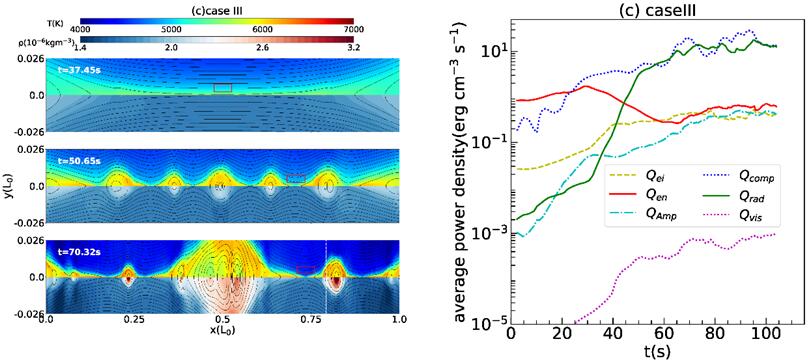Recently, the Theoretical Research Group of Solar Activities and CMEs from Yunnan Observatories, Chinese Academy of Sciences (CAS) has obtained new progress in the numerical simulation of Ellerman bombs (EBs). The research was carried out by master student LIU Mingyu and Professor NI Lei, and was published in Research in Astronomy and Astrophysics.
The EB is a kind of small scale reconnection events, which are ubiquitously formed in the upper photosphere or the lower chromosphere. The low temperature (<10,000 K) and high density (~1019-1022) plasma there make the magnetic reconnection process strongly influenced by the partially ionized effects and the radiative cooling.
Researchers studied the high $\beta$ magnetic reconnection near the solar temperature minimum region (TMR) based on high-resolution 2.5D magnetohydrodynamics (MHDs) simulations. The time-dependent ionization degree of hydrogen and helium are included to realize more realistic diffusivities, viscosity and radiative cooling in simulations.
Numerical results show that both the large value of $\eta_{en}$ (magnetic diffusion caused by the electron-neutral collision) and the plasmoid instability contribute to the fast magnetic reconnection in the EB-like event. The Joule heating contributed by $\eta_{en}$ can play a major role to heat plasmas when the magnetic reconnection in EBs is during the quasi-steady stage with smaller temperature increases. After plasmoid instability appears, the interactions and coalescence of plasmoids strongly enhance the local compression heating effect, which becomes the dominant mechanism for heating EBs. The value of the average power density contributed by compression heating (Qcomp) can reach above 10 erg cm-3 s-1, which can supply 1027 erg energy for a typical EB with the size of (700 km)3 and lifetime of 5 minutes. The results also show that the radiative cooling effect suppresses the temperature increase to a reasonable range, increases the reconnection rate and the generation of thermal energy.
In this study, the magnetic reconnection and heating mechanisms for the EB-like events are studied by MHD simulations and important results are obtained.
This research is supported by the National Key R&D Program of China; the National Natural Science Foundation of China; the Strategic Priority Research Program of CAS with grants; the outstanding member of the Youth Innovation Promotion Association CAS; the Applied Basic Research of Yunnan Province in China Grant; the Yunling Talent Project for the Youth; the project of the Group for Innovation of Yunnan Province grant; the Yunling Scholar Project of the Yunnan Province and the Yunnan Province Scientist Workshop of Solar Physics; Yunnan Key Laboratory of Solar Physics and Space Exploration. The numerical calculations and data analysis were done at the Hefei Advanced Computing Center and the Computational Solar Physics Laboratory of Yunnan Observatories.
Contact:
NI Lei
Yunnan Observatories, CAS
Email: leini@ynao.ac.cn

The left panel shows the 2D distributions of temperature(upper panels) and plasma density(lower panels) at three typical times in the area of the reconnection region for EB. The right panel shows the time evolutions of the average power density contributed by different heating terms and the radiative cooling in the area of the reconnection region.